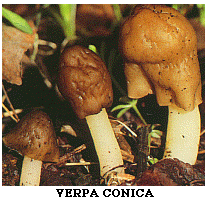
Hunting the Morels
in Upper Michigan
Poisonous and Non-poisonous
Where to find them and how to identify them.
Get ready for spring !

in Upper Michigan
Poisonous and Non-poisonous
Where to find them and how to identify them.
Get ready for spring !
Spring in the Upper Peninsula means morels. Morels are
delicious wild mushrooms, simple to identify, fairly easy to find,
and generally safe to eat. For the beginning mushroom hunter the
morels are the safest group among the more than 2,000 kinds of wild
mushrooms found in Michigan. Like any other outdoor recreation, mushroom hunting is safe
for the person who learns the rules and plays by them. It is a
foolhardy pastime for the ignorant or the careless.
Michigan. Like any other outdoor recreation, mushroom hunting is safe
for the person who learns the rules and plays by them. It is a
foolhardy pastime for the ignorant or the careless.
The beginning mushroomer should do two things: (1 ) Make your first several mushroom hunts with someone who knows mushrooms. (2) Buy a mushroom guidebook. (Best guidebook on the market is "The Mushroom Hunter's Field Guide" by Nancy Smith Weber.)
May is morel month in Michigan, but actual fruiting time extends from late April to mid-June. Morels are where you find them. Suggestions where to look may be given, but be prepared to cover a lot of ground, and don't expect to find them easily if you are new at the game. Your eye for morels will sharpen with experience. One place to look for mushrooms is in recently burned areas and high-ground stands of hardwoods with plenty of leaf cover.
VERPA BOHEMICA Earliest of morels, usually in late April, caps are dark brown and free of stalk, like a skirt. Fruits in rich, moist soils, along stream banks and swamp edges-edible, but eat with caution. Do not eat in large quantities or every day for a period of several days.
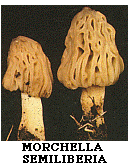
VERPA CONICA smaller than bohemica, fruits a few days later. Caps hang free of stalk, found in forests of mixed conifers and hardwoods, under wild cherry trees, and in old apple orchards. Usually fruits just before the apple trees come to full bloom. Edible.
MORCHELLA SEMILIBERIA - Fruits abundantly about one year in three on moist humus in oak-hickory and beech-maple forests. Color varies from light cream to yellowish-brown. Similar in appearance to morchella esculenta. Cap is detached from the stalk about half way down. Fruits 10 to 15 days after the Verpa Bohemica. Edible.

MORCHELLA AUGUSTICEPS - often called the Black Morel. Color varies from grey in young specimens to almost black in older ones. Hollow cap attached to stalk at lower edge. Fruits in early to mid-May under aspen, birch and balsam fir, occasionally under maple and red pine. Edible and considered choice.

MORCHELLA ESCULENTA - Color varies from light cream to yellowish brown. Hollow cap attached to stalk at base. Fruits in middle or latter half of May. Look for this when the oak leaves are in the "mouse-ear" stage. Fruitings often occur in the same spot for several years. Found in old orchards, beech-maple forests, oak woods, burned over meadows, swampy ground under elms, and occasionally on lawns. Edible and choice.
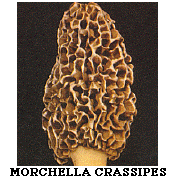
MORCHELLA CRASSIPES - Closely resembles Morchella esculenta, but is bigger. Fruits in late May to early June under oak, in beech-maple forests, old orchards and rich garden soil, and around stumps and stubs of elm trees that have been dead for several years. Edible and choice. One of the best.
GYROMITRA SPECIES are sometimes found growing with or close to the true morels. The amateur collector should consider all species of gyromitra (false morels) to be poisonous and should leave them alone.
GYROMITRA SPECIES. The species, with large, stalked fruiting bodies, grouped under the name gyromitra, are the ones most often collected by morel hunters. These fruiting bodies may be a foot tall and weigh as much as four pounds. Some species of gyromitra seem to be good and safe to eat, certainly they are consumed in quantity, but at least three species have caused serious poisonings. The easiest way to distinguish these species from members of the morel family is to remember that the head of a false morel is never both hollow on the inside and sponge-like on the outside. Furthermore, the surface of the head is usually brighter in color than that of a morel, often some shade of dull red, red brown, or yellow brown.
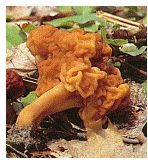
GYROMITRA ESCULENTA, the beefsteak morel , or "the" false morel, is, after the true morels, the most important spring mushroorn that mushroomers need to know. The beefsteak morel has caused more serious poisonings and fatalilies than any other species that fruits in ths spring.
Its fruiting bodies have been likened to a crumpled rusty can or mass of sunburned earthworms on a stick. In young specimens the stalk appears to be stuffed with cotton. By maturity, the "cotton' collapses and the stalk is hollow but note that the hollow does not extend into the head as it does in a true morel. The head is lobed and wrinkled, somewhat in the manner of a collapsing parachute or the surface of brain. The head varies in color from dingy yellow to brownish red.
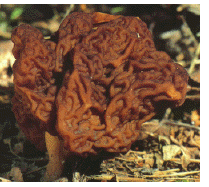
Of all the morels and lorchels that occur in Michigan, the beefsteak morel has about the longest fruiting time on record, from early April into June. It occurs in a variety of habitats primarily on sandy soil and under pines and aspens; however, it has been found under hardwoods and in open sunny areas as well. This species apparently does not occur in the southern portion of the Lower Peninsula, but it is abundant in the Upper Peninsula. Fruiting bodies of this species, under certain conditions, yield the same compound as is used in some rocket fuels. It will not put you in orbit, but it might put you "out". There is more controversy about the edibility of this species than any other wild mushroom in Michigan.
Many people consume beefsteak morels, gyromitra esculenta, without developing noticeable symptoms of hydrazine poisoning. As a result, people think these are perfectly safe to eat and pass them around to their friends or sell them with no warnings. They are not a safe species to consume in quantity, no matter how they are prepared. Of the recorded poisonings by the beefsteak morel, 14% were fatal.
Information on this page is from "A Morel Hunter's Companion, A Guide to True and False Morels," by Nancy Smith Weber, James A. Weber, Chief Photographer, Thunder Bay Press, Lansing Michigan, 1995. Get this guidebook before you collect even one morel.
Back to Upper Peninsula Recreation
Back to Curtis, Michigan Recreation Page
Back to the Upper Peninsula Traveler
Back to the Northern Wisconsin Traveler
Copyright 1998 by Vivian Wood, the webmaster for Exploring the North, Inc. All Rights Reserved. Except as permitted under the Copyright Act of 1976, as Amended, this web site may not be reproduced in whole or in part in any manner. Unless authorized by the webmaster of Exploring the North, Inc., reproduction of any web page or pages on the Exploring the North website for placement on the internet is a copyright infringement. All right, title and interest in and to the material on the web pages, the web site, in whole or in part, and in and to this url and the urls contained within, is the property of the webmaster for Exploring the North, Inc.